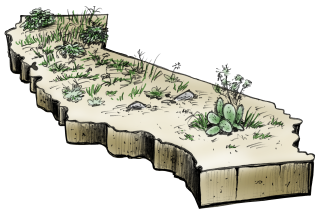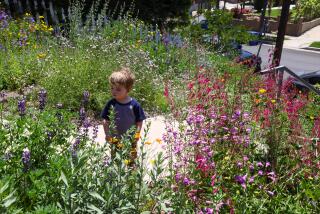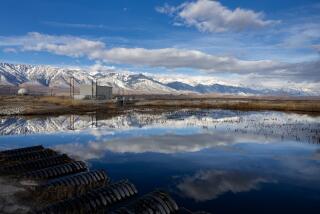Drought’s Over, but Conservation Habits Still Reign
- Share via
Four years after torrential winter rains brought one of California’s worst droughts to an end, Southern California families can still feel the drought’s lingering impact.
They feel it in the water bills that go up exponentially if they use more water than the city thinks is necessary. They feel it in a proliferation of drought-tolerant plants. They feel it in the low-flow toilets and shower heads that save the region more than 14 billion gallons of water every year.
Although water use is slowly creeping up as the drought fades from memory, it is nowhere near pre-drought levels, said George Martin, a water resources and conservation specialist with the Los Angeles Department of Water and Power.
“People are conserving,” said Rob Hallwachs, spokesman for the Metropolitan Water District, which serves 27 Southern California municipalities and communities. “The habits they learned during the drought have for the most part held on.”
Even Martha Davis, executive director of the fiercely pro-conservation Committee to Save Mono Lake, which historically views the Southland as a water waster, calls the area’s efforts to reduce water use “enormously successful.”
Indeed, water use in Los Angeles, which peaked at 713,449 acre-feet in 1989, was down to 628,000 acre-feet in 1995, despite an increase in the city’s population, according to DWP figures. (An acre-foot equals 326,000 gallons.)
Spurring the drive to conserve are a number of factors, including state laws requiring the sale of only low-flow toilets and shower heads, and a new appreciation for the fact that Southern California is just plain dry--particularly in the summer.
Most significant, however, appear to be the high prices implemented throughout the region as a way to force consumers to use less water.
Bob Sherman, who owns the Iverson Movie Ranch in Chatsworth, planted more drought-tolerant landscape and has reduced his bimonthly water bill on the 30-acre property from $4,000 to $800. The landscaping change had nothing to do with aesthetics, only price. “My place doesn’t look as good as it did,” he said.
Kizzie Douglas has forgone a water-hungry lawn at her Los Angeles home, opting instead to plant a ground cover of drought-tolerant succulents.
A primary motivator, she said, has been a city policy to triple water rates if a household’s usage goes above a certain point, usually about 13,000 gallons per month.
“One way or another, you’re going to pay for it,” said Douglas, who maintains a vegetable garden even as she watches her water.
Still, the passage of time has dulled some of the passion for conservation. Cathy Young, a landscape designer, says homeowners rarely ask for fully drought-tolerant landscaping any more.
At the Home Depot store in Playa del Rey on a recent weekday morning, Jill Sperling’s cart was filled with gorgeous flowering plants. But her choice of three types of bougainvillea, a flowering vine and tall lilies to go next to the soft grassy lawn at her new home in the Miracle Mile district were a conservationist’s nightmare.
Saving water? “I’ve just never really thought about it,” Sperling said.
Experts say much of the region’s conservation has come about somewhat unintentionally through the use of low-flow plumbing.
Most water agencies offer rebates for low-flow toilets, and some community groups have made a bundle for pet projects by distributing them. A church group in Reseda, for example, raised $227,000 by handing out 9,100 of the frugal flushers.
The MWD estimates that there are now about 1 million of them in use in Southern California, saving about 3 1/2 gallons per flush, and 14.3 billion gallons per year.
That’s enough, said MWD spokesman Hallwachs, to serve 88,000 families of four in single-family homes for a year. It’s even enough to water their lawns.
David Whitney, plumbing manager at Home Depot in Playa del Rey, said another way to save water would be to install a pump to recirculate water from the “hot” tap to the heater, eliminating the need to let it run to heat up.
Low-flow faucets are also on the market now.
Outside the house, plastic swimming pool covers have become popular among owners concerned about evaporation, which in the typical 18-by-36-foot backyard pool can mean a loss of 20,000 gallons a year, said Allen Fogle, manager of a swimming pool supply business in Chatsworth.
Fogle said that sales of such covers have increased since the drought to about 20 per month at his small retail store.
Added together, these large and small innovations have saved enough water to accommodate some of the increases in water use from what Steve Dreher, a specialist in native plants, calls “the return of the banana tree.”
With the drought behind us, Dreher said, there is renewed interest in water-loving tropical plants, which symbolize to some the image of Los Angeles as a lush paradise.
Dreher, who manages the native plant nursery at the Theodore Payne Foundation in Sunland, said he encourages consumers to compromise, and plant water-hungry plants in a small, decorative area near the house.
“As you go farther away from the house,” Dreher said, “the landscape should be more and more drought tolerant.”
Such a balancing act between wet and dry appears to be on the minds of many homeowners as they waver between that thirsty banana tree and a nice dry dusty sage. It’s OK for the back hillside to look like the lone prairie, these consumers say, but not the front lawn.
“My back yard is all drought-resistant,” said Chatsworth resident Eric Sandifer.
The front, he said, as he loaded water-loving roses into his pickup, is a different matter.
“I think it’s worth it to pay a little bit for water,” Sandifer said. “We have some neighbors who don’t water their front lawns and it looks awful.”
(BEGIN TEXT OF INFOBOX / INFOGRAPHIC)
Fluctuating Water Use
Water use in Los Angeles has increased since 1991, when water was rationed to combat drought, but remains below its peak in 1989.
Los Angeles Yearly Water Use (in acre-feet)
1977: 505,827
1995: 628,000
Source: Los Angeles Department of Water and Power
More to Read
Sign up for Essential California
The most important California stories and recommendations in your inbox every morning.
You may occasionally receive promotional content from the Los Angeles Times.










